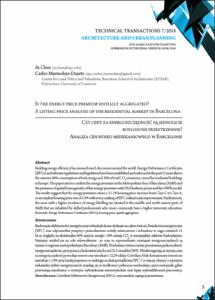Is the energy price premium spatially aggregated? A listing price analysis of the residential market in Barcelona

Visualitza/Obre
10.4467/2353737XCT.18.097.8792
Inclou dades d'ús des de 2022
Cita com:
hdl:2117/120980
Tipus de documentArticle
Data publicació2018-07
EditorTadeusz Kosciuszko University of Technology
Condicions d'accésAccés obert
Llevat que s'hi indiqui el contrari, els
continguts d'aquesta obra estan subjectes a la llicència de Creative Commons
:
Reconeixement-NoComercial-SenseObraDerivada 3.0 Espanya
Abstract
Building energy efficiency has aroused much discussion around the world. Energy Performance Certificates (EPCs) and relevant regulations and legislation have been established and enforced in the past 15 years due to the extreme 40% consumption of total energy and 38% of total CO2 emissions caused by residential buildings in Europe. This paper aims to confirm the energy premium in the Metropolitan Area of Barcelona (AMB) and the presence of spatial homogeneity of this energy premium with OLS hedonic prices and the GWR model. The results suggest that the energy premium causes a 12.2% housing price increase from Class G to Class A, or an implicit housing price rise of 1.9% with every ranking of EPC ordinal scale improvement. Furthermore, the areas with a higher incidence of energy labelling are situated in the middle and north-eastern parts of AMB that are inhabited by skilled professionals who more commonly have a higher university education.
CitacióChen, A., Marmolejo, C. Is the energy price premium spatially aggregated? A listing price analysis of the residential market in Barcelona. "Czasopismo techniczne: architektura = Technical transactions: architecture", Juliol 2018, vol. 7, p. 5-19.
ISSN0011-4561
| Fitxers | Descripció | Mida | Format | Visualitza |
|---|---|---|---|---|
| ChenA_EnergyPrice.pdf | 5,484Mb | Visualitza/Obre |


